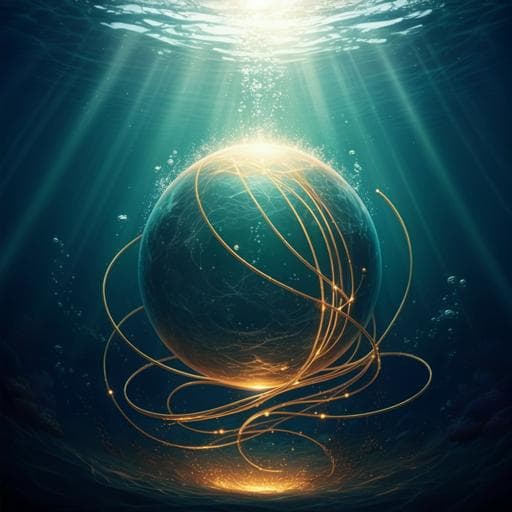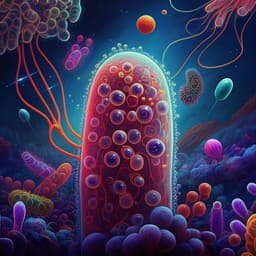
Engineering and Technology
Shadow enhanced self-charging power system for wave and solar energy harvesting from the ocean
Q. Zhang, Q. Liang, et al.
Discover an innovative approach to harnessing renewable energy from the ocean with the shadow-tribo-effect nanogenerator! Researchers Qian Zhang, Qijie Liang, Dilip Krishna Nandakumar, and their team have developed a self-charging power system that captures both wave and solar energy while overcoming the challenges posed by moving shadows. This groundbreaking method promises faster energy storage, paving the way for the next generation of blue energy harvesting.
~3 min • Beginner • English
Introduction
The study addresses the global need for clean, renewable energy by exploiting the vast potential of ocean resources, specifically combining wave energy with abundant solar radiation over the oceans. While triboelectric nanogenerators (TENGs) can convert low-frequency mechanical energy from waves, their output is typically intermittent and of low magnitude, motivating hybrid systems for higher, more stable power. Conventional triboelectric–photovoltaic hybrids face a critical challenge: moving objects in the system cast shadows that degrade photovoltaic performance. The research question is whether a hybrid device can convert both mechanical (wave) energy and solar energy—including utilizing shadows rather than being hindered by them—into usable electrical power, and store it in an integrated manner. The purpose is to design and demonstrate a shadow-tribo-effect nanogenerator (S-TENG) that combines tribo-effect (TE) and a shadow-effect (SE) based on work-function contrasts under partial illumination, integrated with fiber-supercapacitors (F-SCs) into an ocean-deployable “energy ball.” The significance lies in turning the detrimental shadowing into a beneficial energy-harvesting mechanism, enabling continuous wave/solar energy capture and on-board storage for blue energy applications such as seawater electrolysis.
Literature Review
Prior work has established TENGs as promising for harvesting low-frequency wave energy, including solid–liquid interface triboelectrification and nanoparticle-enhanced designs achieving improved current and up to ~9.8% conversion efficiency. However, TENG outputs are often pulsed and limited, requiring hybridization with other modalities and effective power management/storage. Supercapacitors are advantageous for such systems due to robustness and cycle life; MoS2 has emerged as an attractive electrode material because of high surface area, interlayer spacing for ion intercalation, and multiple oxidation states. Existing hybrid triboelectric–photovoltaic systems have typically relied on transparent moving media (e.g., raindrops) or avoided shadowed PV regions, since shadows reduce PV output. Recent studies demonstrated that optical shading can induce work function contrasts at metal/semiconductor junctions, driving electron flow from bright to dark regions—the shadow-effect—which can be harnessed for energy harvesting. This work builds on these insights by integrating the shadow-effect with triboelectric generation in a single device to overcome shadow-induced PV losses and to create a more effective hybrid ocean energy harvester with integrated storage.
Methodology
Device design and working principles:
- S-TENG architecture: An Au/n-Si Schottky system (15 nm Au on n-type Si, with a 1 cm wide gap in the Au film) is overcoated with a transparent PDMS tribo-layer. The device exploits (i) tribo-effect (TE) from contact–separation between PDMS and a moving object and (ii) shadow-effect (SE) from partial illumination creating work function contrasts on the Au surface that drive lateral electron flow from bright to dark regions via the external circuit.
- Energy band and SE mechanism: Under illumination, photocarriers in n-Si are separated by the Schottky field and injected into Au, lowering the illuminated Au work function relative to the dark region, establishing an in-plane potential gradient. Kelvin probe force microscopy (KPFM) characterized the Au/n-Si surface potential shift under light vs dark; a work function change from 5.26 eV (dark) to 5.39 eV (20 mW cm−2 illumination) was observed.
- TE mechanism: Contact with PDMS leaves negative tribo-charges; periodic approach/retraction of an opaque object induces alternating electron flow between electrodes (AC under dark). With illumination, the SE contributes a DC component; combined, the device behaves as parallel TE (capacitive source) and SE (voltage source with internal resistance), described by V_AB = Q/C_T + V_TE = V_SE − I R_T.
Materials and configuration:
- Substrates and layers: n-type Si wafer (area ~15 cm², thickness 530 µm), thermally evaporated Au (15 nm optimal; thickness study included 15/60/240 nm), PDMS layer applied by doctor blading and annealed at 60 °C for 2 h.
- Gap engineering: Removing a 1 cm central strip of Au increases external electron transport path for SE, boosting J_SC from ~8.5 to ~39 µA cm−2 under half-shadow conditions.
- Transparency: PDMS was confirmed not to reduce visible–NIR transmittance on glass. Au transmittance decreases with thickness (15 < 60 < 240 nm), impacting photocarrier generation; thus 15 nm was selected.
- Shadow area optimization: Performance was measured for various shadowed-area ratios; 50% shadowing yielded higher J_SC and V_OC than 0%, 20%, 80%, or 100%, indicating optimal illumination contrast.
Fiber-supercapacitors (F-SCs):
- Electrode fabrication: Carbon fibers (pretreated in acetone/ethanol/DI water) were dip-coated in few-layer MoS2 (0.04 g in 5 mL ethanol), soaked 24 h, baked at 150 °C; the soak–bake cycle was repeated to achieve uniform coating. Two MoS2-coated carbon fibers were assembled with H2SO4/PVA gel electrolyte (prepared by dissolving 6 g H2SO4 and 6 g PVA in 60 mL water at 85 °C) to form one F-SC; five F-SCs were assembled similarly.
- Characterization: XRD identified few-layer MoS2 peaks at ~33.69° (100), 59.51° (110), with (103), (105) features. Raman showed E2g1 and A1g modes with layer-number dependence. SEM confirmed uniform coating on ~400 µm diameter fibers.
- Electrochemistry: CV (10–100 mV s−1) retained rectangular shape up to 100 mV s−1, indicating good rate capability. GCD (20–100 µA) showed linear, symmetric curves. Specific capacitance reached 196.4 F g−1 at 2 A g−1; energy density ~27.3 Wh kg−1 and average power density ~1 kW kg−1 (at 20 µA). Cycle stability: ~94% capacitance retention after 1200 GCD cycles at 40 µA. Five F-SCs in series supported up to 5 V, maintaining CV rectangularity up to 2 V s−1; derived capacitances were ~0.416 mF at 20 µA and 1.096 mF at 200 nA.
Energy ball integration and testing:
- Assembly: The S-TENG and five F-SCs were integrated into a transparent plastic sphere (diameter 8 cm). A 2.5 cm aluminum (Al) ball served as the opaque moving object casting shadows on the S-TENG. A counterweight ensured buoyancy stability. A small full-wave rectifier interfaced the S-TENG to F-SCs for power management.
- Test setup: Ocean surface was simulated using a wave machine (Jebao OW-10) and a lamp as the light source. Electrical measurements used a Stanford SR570 current preamplifier, Rigol DS4052 oscilloscope (100 MΩ), and Keithley 6514 electrometer. A force gauge system (Mecmesin MultiTest 2.5-i) controlled contact frequency, force (0.1 N), and motion for benchtop tests.
- Operating modes: SE-only charging (closing SW1 and SW2) directly charged F-SCs without rectification (DC). For wave-driven TE, rectification (close SW3) produced higher-voltage outputs (~4.1 V after diode drop), blocking low-voltage SE contributions and avoiding impedance mismatch between TE and SE. Loads were powered by opening SW1–3 and closing SW4 after charging.
Performance characterization:
- Benchtop S-TENG: Under dark (TE only), AC J_SC peaks ~0.005–0.01 µA cm−2; under illumination (~90–100 mW cm−2), DC J_SC up to ~34 µA cm−2. Stronger shadows (glass with black paper vs glass only) increased J_SC (to ~43 vs ~8.2 µA cm−2). Frequency dependence: TE current increased with frequency (0.02–0.1 Hz), consistent with J_SC = (dQ_SC/dx)·v; SE-dominated output showed little frequency dependence but increased with light intensity. Single-electrode TENG connection yielded V_OC ~80 V, charge ~34 nC, and max power density ~0.28 µW cm−2 at ~8 GΩ.
- Energy ball: J_SC rose with wave intensity (small, medium, large). Load sweep under illumination showed peak power density ~718 µW cm−2 at 100 Ω; current decreased slowly above 100 kΩ indicating SE’s lower internal impedance than TE. Stability: ~700 s continuous operation without degradation. Angle-of-incidence effects were characterized separately.
Applications:
- Self-charging: SE-only rapidly raised F-SC voltage from 0 to ~0.2 V in ~4 s. Wave-only charging to 0.3 V took ~409.4 s; combined wave + shadow reduced charging time to ~156.1 s (a 253.3 s improvement to reach 0.3 V).
- Seawater electrolysis: Four energy balls in series charged five F-SCs in series to ~1.3 V, then discharged through a carbon fabric anode and Pt cathode (each 4 cm²) to split synthetic seawater, demonstrating circuit management for energy use and recharging cycles. Overall energy efficiency of the energy ball estimated at ~0.7% under shadow-enhanced conditions. Idealized peak areal power projected at ~0.69 MW km−2.
Fabrication details (Methods):
- S-TENG: n-Si wafer (15 cm²) with 15 nm Au (evaporated), central 1 cm Au removed; PDMS coated and annealed at 60 °C for 2 h; integrated into 8 cm sphere with 2.5 cm Al ball and counterweight; F-SCs embedded beneath and wired via full-wave rectifier.
- F-SCs: Carbon fiber pretreatments; few-layer MoS2 dip-coating and bake cycles; H2SO4/PVA gel electrolyte preparation and assembly; five devices made for series connection.
- Measurement instruments and seawater composition are detailed to ensure reproducibility.
Key Findings
- Shadow-effect validation: KPFM showed Au/n-Si work function shift from 5.26 to 5.39 eV under 20 mW cm−2 illumination; partial shadowing generates in-plane potential gradients enabling lateral current.
- Optimized electrode design: 15 nm Au yielded the highest SE output; introducing a 1 cm gap increased half-shadow J_SC from ~8.5 to ~39 µA cm−2 without changing V_OC.
- Stronger shadow, higher output: With a moving transparent glass vs glass + black paper, illuminated S-TENG J_SC increased from ~8.2 to ~43 µA cm−2; 50% shadow area ratio maximized output among tested ratios.
- Benchtop electrical performance: Under dark (TE only), AC J_SC peaks ~0.005–0.01 µA cm−2; under illumination (~90–100 mW cm−2), DC J_SC up to ~34 µA cm−2. In single-electrode TENG configuration, V_OC ~80 V, charge ~34 nC, and maximum power density ~0.28 µW cm−2 at ~8 GΩ.
- Energy ball performance: Peak power density ~718 µW cm−2 at 100 Ω load under illumination; current decreases slowly above 100 kΩ (SE lower internal impedance than TE). Stable operation demonstrated for >700 s under waves + light.
- Self-charging improvement: SE-only raised F-SC voltage from 0 to 0.2 V in ~4 s. To reach 0.3 V, wave-only charging required ~409.4 s; combined wave + shadow reduced time to ~156.1 s (253.3 s shorter).
- F-SC metrics: Specific capacitance 196.4 F g−1 at 2 A g−1; energy density ~27.3 Wh kg−1 and average power density ~1 kW kg−1 (at 20 µA); ~94% capacitance retention after 1200 cycles. Five F-SCs in series supported up to 5 V; capacitances ~0.416 mF (20 µA) and 1.096 mF (200 nA).
- Application demo: Four energy balls in series charged five F-SCs in series to ~1.3 V, then performed seawater splitting with carbon fabric/Pt electrodes. Estimated system energy efficiency ~0.7% under shadow-enhanced conditions; idealized areal peak power ~0.69 MW km−2.
Discussion
The study demonstrates that shadows—typically detrimental for photovoltaics—can be exploited to generate electricity via work function contrasts (shadow-effect) in an Au/n-Si Schottky system. By hybridizing SE with tribo-effect in a single S-TENG device and integrating with fiber-supercapacitors, the energy ball converts both light and wave energy into stored electrical energy. The SE contribution supplies a DC current largely independent of contact frequency and enhanced by higher light intensity and darker shadows, while the TE contributes high-voltage pulses suitable for rectification and charging to higher voltages. Circuit management (switching and rectification) resolves the impedance mismatch between SE (low internal resistance, low voltage) and TE (high internal resistance, high voltage), allowing combined operation without mutual interference. The result is significantly faster charging of integrated supercapacitors under simultaneous wave and shadow stimuli compared to wave-only operation, along with robust, stable output suitable for powering processes like seawater electrolysis. The work reframes the role of shadows in oceanic hybrid harvesters and suggests scalable ocean-surface deployments where moving objects naturally produce beneficial illumination contrasts.
Conclusion
This work introduces a shadow-enhanced, self-charging hybrid power system that co-harvests ocean wave and solar energy using an S-TENG coupled to few-layer MoS2 fiber-supercapacitors, packaged as an “energy ball.” The device attains a peak power density of ~718 µW cm−2 under illumination with waves, far exceeding TE-only power (~0.28 µW cm−2 in single-electrode tests), and shortens charging time to reach 0.3 V by 253.3 s when combining wave + shadow versus wave alone. The integrated F-SCs provide high capacitance, strong rate capability, and >90% cycle retention over 1200 cycles, enabling stable energy storage and on-demand delivery demonstrated by seawater electrolysis. The concept converts shadowing from a limitation into a functional energy source and offers a path toward large-scale blue energy harvesting and circuit-managed, all-day energy conversion and storage. Future work could focus on large-area array integration, marine-grade durability testing over long periods, materials optimization for higher SE voltage and efficiency, advanced rectification/power electronics for minimal losses, and application-specific packaging for hydrogen generation and ocean IoT.
Limitations
- The shadow-enhanced system efficiency is currently modest (~0.7% under reported conditions), indicating room for optimization in materials, optics, and power electronics.
- SE output voltage (~0.2 V) is insufficient to pass typical diode drops in rectifiers, necessitating circuit strategies that prioritize TE for high-voltage charging; SE contributions are then utilized primarily for rapid low-voltage charging stages.
- Performance depends on illumination intensity and shadow contrast; varying environmental conditions (e.g., cloud cover, turbidity, biofouling) may impact SE effectiveness.
- Stability was demonstrated over ~700 s in lab simulations; long-term durability in harsh marine environments (salt spray, biofouling, UV, mechanical fatigue) was not fully assessed.
- Reported peak areal power (~0.69 MW km−2) is an idealized estimate; real-world deployment efficiencies and packing factors may reduce practical outputs.
Related Publications
Explore these studies to deepen your understanding of the subject.







